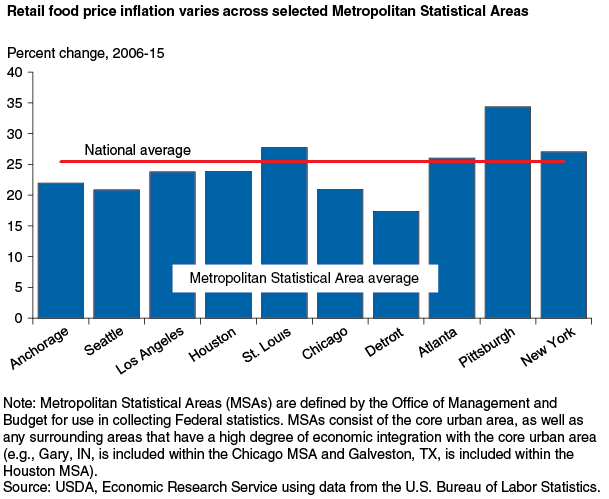Retail Food Price Inflation Varies Geographically
- by Annemarie Kuhns and David Levin
- 5/2/2016
Between 2006 and 2015, food prices in supermarkets, supercenters, convenience stores, and other retailers rose 25.5 percent nationally, at a time when overall inflation rose 17.6 percent. Retail food price inflation, however, varies by geographic location. For example, over the same 10-year period, retail food prices rose 34.4 percent in Pittsburgh but 17.4 percent in Detroit. Several factors account for variations in food price inflation across major metropolitan statistical areas (MSAs), including differences in consumer tastes and preferences, shifts in transportation and retailing costs, and consumers’ changing income levels.
Retail food price inflation for a specific metropolitan area is measured using the area’s “market basket” of foods. This basket reflects the types and quantities of foods purchased by the average consumer in that area. Because consumers might purchase different combinations of foods across areas, the baskets may exhibit different levels of inflation as inflation rates also vary by food category. For example, MSAs where consumers purchase more meat products than dairy products may have higher retail food price inflation than those MSAs where dairy products are more popular; from 2006 to 2015, meat prices increased 40 percent, whereas dairy prices rose 22.6 percent.
Changes to the costs associated with transporting food products to the grocery store can also vary geographically. ERS research on the relationship between transportation costs and fresh produce prices found a connection between distance traveled and the wholesale price of fresh fruits and vegetables. For this reason, volatility in fuel prices can contribute to variation in retail food price inflation across areas. Changes in fuel costs generally have a larger impact in areas where foods have further to travel.
Fluctuations in retail overhead costs may also differ from one area to another. For example, rising labor and land costs in a particular area may make it more expensive to open a new store or to operate an existing one than it would in another area. Increases in retail overhead costs are often passed onto consumers as higher shelf prices.
In addition to individual tastes and preferences, budget constraints influence consumers’ food purchase decisions. Thus, areas with higher consumer income growth may see above-average retail food price inflation, as income growth generally makes it easier for grocers to pass price increases on to these less-price-sensitive consumers. Grocers in areas with lower income growth, on the other hand, may choose to absorb some, or all, of the rising food, transportation, and overhead costs, leading to lower rates of food price inflation.
This article is drawn from:
- Food Price Outlook. (n.d.). U.S. Department of Agriculture, Economic Research Service.
- Roeger, E. & Leibtag, E. (2013). How Transportation Costs Affect Fresh Fruit and Vegetable Prices. U.S. Department of Agriculture, Economic Research Service. ERR-160.


